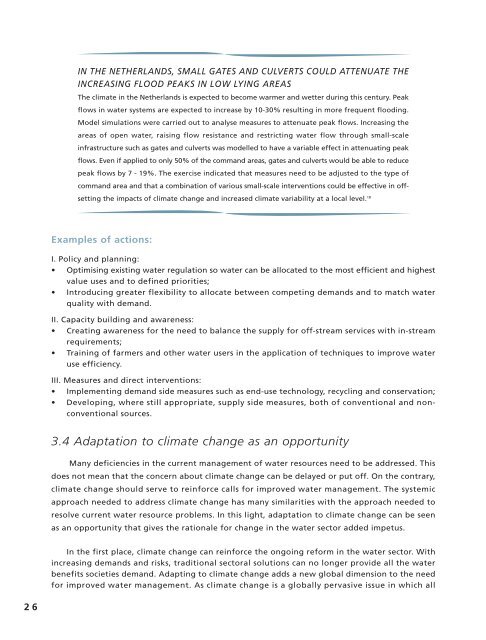Adaptation of water resources management to climate change
Adaptation of water resources management to climate change
Adaptation of water resources management to climate change
You also want an ePaper? Increase the reach of your titles
YUMPU automatically turns print PDFs into web optimized ePapers that Google loves.
IN THE NETHERLANDS, SMALL GATES AND CULVERTS COULD ATTENUATE THEINCREASING FLOOD PEAKS IN LOW LYING AREASThe <strong>climate</strong> in the Netherlands is expected <strong>to</strong> become warmer and wetter during this century. Peakflows in <strong>water</strong> systems are expected <strong>to</strong> increase by 10-30% resulting in more frequent flooding.Model simulations were carried out <strong>to</strong> analyse measures <strong>to</strong> attenuate peak flows. Increasing theareas <strong>of</strong> open <strong>water</strong>, raising flow resistance and restricting <strong>water</strong> flow through small-scaleinfrastructure such as gates and culverts was modelled <strong>to</strong> have a variable effect in attenuating peakflows. Even if applied <strong>to</strong> only 50% <strong>of</strong> the command areas, gates and culverts would be able <strong>to</strong> reducepeak flows by 7 - 19%. The exercise indicated that measures need <strong>to</strong> be adjusted <strong>to</strong> the type <strong>of</strong>command area and that a combination <strong>of</strong> various small-scale interventions could be effective in <strong>of</strong>fsettingthe impacts <strong>of</strong> <strong>climate</strong> <strong>change</strong> and increased <strong>climate</strong> variability at a local level. 18Examples <strong>of</strong> actions:I. Policy and planning:• Optimising existing <strong>water</strong> regulation so <strong>water</strong> can be allocated <strong>to</strong> the most efficient and highestvalue uses and <strong>to</strong> defined priorities;• Introducing greater flexibility <strong>to</strong> allocate between competing demands and <strong>to</strong> match <strong>water</strong>quality with demand.II. Capacity building and awareness:• Creating awareness for the need <strong>to</strong> balance the supply for <strong>of</strong>f-stream services with in-streamrequirements;• Training <strong>of</strong> farmers and other <strong>water</strong> users in the application <strong>of</strong> techniques <strong>to</strong> improve <strong>water</strong>use efficiency.III. Measures and direct interventions:• Implementing demand side measures such as end-use technology, recycling and conservation;• Developing, where still appropriate, supply side measures, both <strong>of</strong> conventional and nonconventionalsources.3.4 <strong>Adaptation</strong> <strong>to</strong> <strong>climate</strong> <strong>change</strong> as an opportunityMany deficiencies in the current <strong>management</strong> <strong>of</strong> <strong>water</strong> <strong>resources</strong> need <strong>to</strong> be addressed. Thisdoes not mean that the concern about <strong>climate</strong> <strong>change</strong> can be delayed or put <strong>of</strong>f. On the contrary,<strong>climate</strong> <strong>change</strong> should serve <strong>to</strong> reinforce calls for improved <strong>water</strong> <strong>management</strong>. The systemicapproach needed <strong>to</strong> address <strong>climate</strong> <strong>change</strong> has many similarities with the approach needed <strong>to</strong>resolve current <strong>water</strong> resource problems. In this light, adaptation <strong>to</strong> <strong>climate</strong> <strong>change</strong> can be seenas an opportunity that gives the rationale for <strong>change</strong> in the <strong>water</strong> sec<strong>to</strong>r added impetus.In the first place, <strong>climate</strong> <strong>change</strong> can reinforce the ongoing reform in the <strong>water</strong> sec<strong>to</strong>r. Withincreasing demands and risks, traditional sec<strong>to</strong>ral solutions can no longer provide all the <strong>water</strong>benefits societies demand. Adapting <strong>to</strong> <strong>climate</strong> <strong>change</strong> adds a new global dimension <strong>to</strong> the needfor improved <strong>water</strong> <strong>management</strong>. As <strong>climate</strong> <strong>change</strong> is a globally pervasive issue in which all26











![View full document [PDF 988.55 KB] - PreventionWeb](https://img.yumpu.com/47733942/1/184x260/view-full-document-pdf-98855-kb-preventionweb.jpg?quality=85)
![View full document (in French) [PDF 4.96 MB] - PreventionWeb](https://img.yumpu.com/47223870/1/184x260/view-full-document-in-french-pdf-496-mb-preventionweb.jpg?quality=85)


![View full document [PDF 25.02 MB] - PreventionWeb](https://img.yumpu.com/44204570/1/190x234/view-full-document-pdf-2502-mb-preventionweb.jpg?quality=85)
